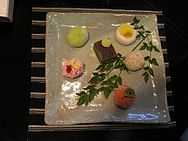Wagashi
| Wagashi | |
|---|---|
|
Hotaru (firefly) wagashi | |
| Type | Confectionery |
| Place of origin | Japan |
|
| |



Wagashi (和菓子 wa-gashi) is a traditional Japanese confectionery which is often served with tea, especially the types made of mochi, anko (azuki bean paste), and fruits. Wagashi is typically made from plant ingredients.[1]
History
In Japan the word for sweets, okashi (お菓子), originally referred to fruits and nuts.[2] China learned from India how to produce sugar and began trading it to Japan.[2] The trade increased and sugar became a common seasoning by the end of the Muromachi period.[2] Influenced by the introduction of tea and China's confectionery and dim sum, the creation of wagashi took off during the Edo period in Japan.[2]
Types
- Anmitsu: chilled gelatinous cubes (kanten) with fruit
- Amanattō: simmered azuki beans or other beans with sugar, and dried - amanattō and nattō are not related, although the names are similar.
- Botamochi: a sweet rice ball wrapped with anko (or an, thick azuki bean paste)
- Daifuku: general term for mochi (pounded sweet rice) stuffed with anko
- Dango: a small, sticky, sweet mochi, commonly skewered on a stick
- Dorayaki: a round, flat sweet consisting of castella wrapped around anko
- Hanabiramochi: a flat, red and white, sweet mochi wrapped around anko and a strip of candied gobo (burdock)
- Ikinari dango: a steamed bun with a chunk of sweet potato and anko in the center, it is a local confectionery in Kumamoto.
- Imagawayaki (also kaitenyaki): anko surrounded in a disc of fried dough covering
- Kusa mochi: "grass" mochi, a sweet mochi infused with Japanese mugwort (yomogi), surrounding a center of anko
- Kuzumochi
- Kuri kinton: a sweetened mixture of boiled and mashed chestnuts
- Manjū: steamed cakes of an surrounded by a flour mixture, available in many shapes such as peaches, rabbits, and matsutake (松茸) mushrooms
- Mochi: a rice cake made of glutinous rice
- Monaka: a center of anko sandwiched between two delicate and crispy sweet rice crackers
- Oshiruko (also zenzai): a hot dessert made from anko in a liquid, soup form, with small mochi floating in it
- Rakugan: a small, very solid and sweet cake which is made of rice flour and mizuame
- Sakuramochi: a rice cake filled with anko and wrapped in a pickled cherry leaf
- Taiyaki: like a kaitenyaki, a core of anko surrounded by a fried dough covering, but shaped like a fish
- Uirō: a steamed cake made of rice flour and sugar, similar to mochi
- Warabimochi: traditionally made from warabi and served with kinako and kuromitsu
- Yatsuhashi: thin sheets of gyūhi (sweetened mochi), available in different flavors, like cinnamon, and occasionally folded in a triangle around a ball of red anko
- Yōkan: one of the oldest wagashi, a solid block of anko, hardened with agar and additional sugar
- Akumaki: one of the confections of Kagoshima Prefecture
Classification
Wagashi are classified according to the production method and moisture content. Moisture content is very important, since it affects shelf life.
|
|
|
See also
References
- ↑ Gordenker, Alice, "So What the Heck is That?: Wagashi", Japan Times, 20 January 2011, p. 11.
- ↑ 2.0 2.1 2.2 2.3 Ashkenazi, Michael (2000). The Essence of Japanese Cuisine: An Essay on Food and Culture. University of Pennsylvania Press. pp. 106–107. ISBN 9780812235661. Retrieved Jan 30, 2013.
- ↑ Japanese Confectionery Gratifies the Eyes and the Palate Aichi Voice Issue 7, 1997
- Aoki, Naomi (October 2000). 図説 和菓子の今昔 Zusetsu wagashi no konjyaku. 株式会社淡交社 Tankosha Publishing Co.,Ltd. ISBN 978-4-473-01762-8.
External links
| Wikimedia Commons has media related to Wagashi. |
- Japan Wagashi Association (Japanese)
